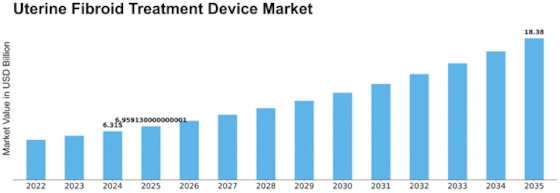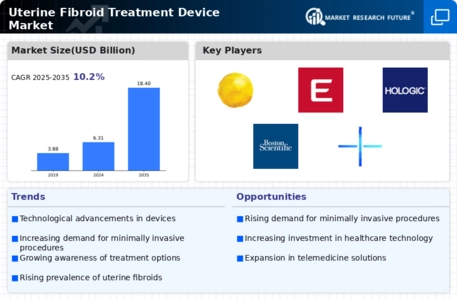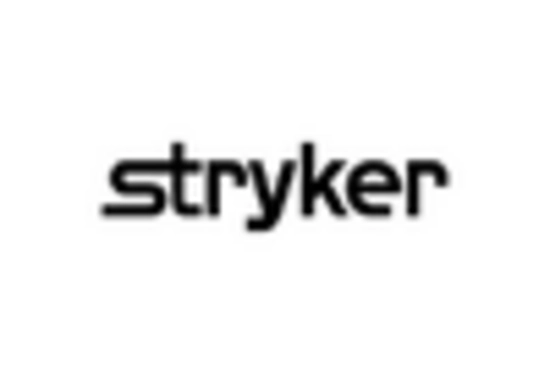-
Executive summary
-
Market Introduction
-
Definition
-
Scope of the Study
- Research Objective
- Assumptions
- Limitations
-
Research Methodology
-
Overview
-
Data Mining
-
Secondary Research
-
Primary Research
- Primary Interviews and Information Gathering Process
- Breakdown of Primary Respondents
-
Forecasting Modality
-
Market Size Estimation
- Bottom-Up Approach
- Top-Down Approach
-
Data Triangulation
-
Validation
-
Market Dynamics
-
Overview
-
Drivers
-
Restraints
-
Opportunities
-
Market Factor Analysis
-
Value Chain Analysis
-
Porter’s Five Forces Analysis
- Bargaining Power of Suppliers
- Bargaining Power of Buyers
- Threat of New Entrants
- Threat of Substitutes
- Intensity of Rivalry
-
COVID-19 Impact Analysis
- Market Impact Analysis
- Regional Impact
- Opportunity and Threat Analysis
-
GLOBAL Uterine Fibroid Treatment Device MARKET, BY Technology
-
Overview
-
Surgical Techniques
-
Laparoscopic Techniques
-
Ablation Techniques
-
Embolization Techniques
-
GLOBAL Uterine Fibroid Treatment Device MARKET, BY Mode of Treatment
-
Overview
-
Invasive Treatment
-
Minimally Invasive Treatment
-
Non-invasive Treatment
-
GLOBAL Uterine Fibroid Treatment Device MARKET, by Region
-
Overview
-
North America
- U.S.
- Canada
-
Europe
- Germany
- France
- U.K
- Italy
- Spain
- Rest of Europe
-
Asia-Pacific
- China
- India
- Japan
- South Korea
- Australia
- Rest of Asia-Pacific
-
Rest of the World
- Middle East
- Africa
- Latin America
-
Competitive Landscape
-
Overview
-
Competitive Analysis
-
Market Share Analysis
-
Major Growth Strategy in the Global Uterine Fibroid Treatment Device Market,
-
Competitive Benchmarking
-
Leading Players in Terms of Number of Developments in the Global Uterine Fibroid Treatment Device Market,
-
Key developments and Growth Strategies
- New TECHNOLOGY Launch/Mode of Treatment Deployment
- Merger & Acquisitions
- Joint Ventures
-
Major Players Financial Matrix
- Sales & Operating Income, 2022
- Major Players R&D Expenditure. 2022
-
Company ProfileS
-
Medtronic
- Company Overview
- Financial Overview
- Technology Offered
- Key Developments
- SWOT Analysis
- Key Strategies
-
Stryker Corporation
- Company Overview
- Financial Overview
- Technology Offered
- Key Developments
- SWOT Analysis
- Key Strategies
-
CooperSurgical Inc.
- Company Overview
- Financial Overview
- Technology Offered
- Key Developments
- SWOT Analysis
- Key Strategies
-
Ethicon, Inc.
- Company Overview
- Financial Overview
- Technology Offered
- Key Developments
- SWOT Analysis
- Key Strategies
-
Hologic, Inc.
- Company Overview
- Financial Overview
- Technology Offered
- Key Developments
- SWOT Analysis
- Key Strategies
-
Minerva Surgical, Inc.
- Company Overview
- Financial Overview
- Technology Offered
- Key Developments
- SWOT Analysis
- Key Strategies
-
Lumenis
- Company Overview
- Financial Overview
- Technology Offered
- Key Developments
- SWOT Analysis
- Key Strategies
-
Boston scientific
- Company Overview
- Financial Overview
- Technology Offered
- Key Developments
- SWOT Analysis
- Key Strategies
-
INSIGHTEC
- Company Overview
- Financial Overview
- Technology Offered
- Key Developments
- SWOT Analysis
- Key Strategies
-
Karl Storz GmbH
- Company Overview
- Financial Overview
- Technology Offered
- Key Developments
- SWOT Analysis
- Key Strategies
-
11.
-
Appendix
-
11.1.
-
References
-
Related Reports LIST OF TABLES
-
Global Uterine Fibroid Treatment Device Market, Synopsis, 2018-2032
-
Global Uterine Fibroid Treatment Device Market, Estimates & Forecast, 2018-2032 (USD BILLION)
-
GLOBAL Uterine Fibroid Treatment Device MARKET, BY TECHNOLOGY, 2018-2032 (USD BILLION)
-
GLOBAL Uterine Fibroid Treatment Device MARKET, BY MODE OF TREATMENT, 2018-2032 (USD BILLION)
-
North America Uterine Fibroid Treatment Device MARKET, BY TECHNOLOGY, 2018-2032 (USD BILLION)
-
North America Uterine Fibroid Treatment Device MARKET, BY MODE OF TREATMENT, 2018-2032 (USD BILLION)
-
North America Uterine Fibroid Treatment Device MARKET, BY Country, 2018-2032 (USD BILLION)
-
U.S. Uterine Fibroid Treatment Device MARKET, BY TECHNOLOGY, 2018-2032 (USD BILLION)
-
U.S. Uterine Fibroid Treatment Device MARKET, BY MODE OF TREATMENT, 2018-2032 (USD BILLION)
-
Canada Uterine Fibroid Treatment Device MARKET, BY TECHNOLOGY, 2018-2032 (USD BILLION)
-
Canada Uterine Fibroid Treatment Device MARKET, BY MODE OF TREATMENT, 2018-2032 (USD BILLION)
-
Europe Uterine Fibroid Treatment Device MARKET, BY TECHNOLOGY, 2018-2032 (USD BILLION)
-
Europe Uterine Fibroid Treatment Device MARKET, BY MODE OF TREATMENT, 2018-2032 (USD BILLION)
-
Europe Uterine Fibroid Treatment Device MARKET, BY Country, 2018-2032 (USD BILLION)
-
Germany Uterine Fibroid Treatment Device MARKET, BY TECHNOLOGY, 2018-2032 (USD BILLION)
-
Germany Uterine Fibroid Treatment Device MARKET, BY MODE OF TREATMENT, 2018-2032 (USD BILLION)
-
France Uterine Fibroid Treatment Device MARKET, BY TECHNOLOGY, 2018-2032 (USD BILLION)
-
France Uterine Fibroid Treatment Device MARKET, BY MODE OF TREATMENT, 2018-2032 (USD BILLION)
-
Italy Uterine Fibroid Treatment Device MARKET, BY TECHNOLOGY, 2018-2032 (USD BILLION)
-
Italy Uterine Fibroid Treatment Device MARKET, BY MODE OF TREATMENT, 2018-2032 (USD BILLION)
-
Spain Uterine Fibroid Treatment Device MARKET, BY TECHNOLOGY, 2018-2032 (USD BILLION)
-
Spain Uterine Fibroid Treatment Device MARKET, BY MODE OF TREATMENT, 2018-2032 (USD BILLION)
-
U.K Uterine Fibroid Treatment Device MARKET, BY TECHNOLOGY, 2018-2032 (USD BILLION)
-
U.K Uterine Fibroid Treatment Device MARKET, BY MODE OF TREATMENT, 2018-2032 (USD BILLION)
-
Rest of Europe Uterine Fibroid Treatment Device MARKET, BY TECHNOLOGY, 2018-2032 (USD BILLION)
-
Rest of Europe Uterine Fibroid Treatment Device MARKET, BY MODE OF TREATMENT, 2018-2032 (USD BILLION)
-
Asia Pacific Uterine Fibroid Treatment Device MARKET, BY TECHNOLOGY, 2018-2032 (USD BILLION)
-
Asia Pacific Uterine Fibroid Treatment Device MARKET, BY MODE OF TREATMENT, 2018-2032 (USD BILLION)
-
Asia Pacific Uterine Fibroid Treatment Device MARKET, BY Country, 2018-2032 (USD BILLION)
-
Japan Uterine Fibroid Treatment Device MARKET, BY TECHNOLOGY, 2018-2032 (USD BILLION)
-
Japan Uterine Fibroid Treatment Device MARKET, BY MODE OF TREATMENT, 2018-2032 (USD BILLION)
-
China Uterine Fibroid Treatment Device MARKET, BY TECHNOLOGY, 2018-2032 (USD BILLION)
-
China Uterine Fibroid Treatment Device MARKET, BY MODE OF TREATMENT, 2018-2032 (USD BILLION)
-
India Uterine Fibroid Treatment Device MARKET, BY TECHNOLOGY, 2018-2032 (USD BILLION)
-
India Uterine Fibroid Treatment Device MARKET, BY MODE OF TREATMENT, 2018-2032 (USD BILLION)
-
Australia Uterine Fibroid Treatment Device MARKET, BY TECHNOLOGY, 2018-2032 (USD BILLION)
-
Australia Uterine Fibroid Treatment Device MARKET, BY MODE OF TREATMENT, 2018-2032 (USD BILLION)
-
south korea Uterine Fibroid Treatment Device MARKET, BY TECHNOLOGY, 2018-2032 (USD BILLION)
-
south korea Uterine Fibroid Treatment Device MARKET, BY MODE OF TREATMENT, 2018-2032 (USD BILLION)
-
Rest of asia-pacific Uterine Fibroid Treatment Device MARKET, BY TECHNOLOGY, 2018-2032 (USD BILLION)
-
Rest of asia-pacific Uterine Fibroid Treatment Device MARKET, BY MODE OF TREATMENT, 2018-2032 (USD BILLION)
-
Rest of WOrld Uterine Fibroid Treatment Device MARKET, BY TECHNOLOGY, 2018-2032 (USD BILLION)
-
Rest of WOrld Uterine Fibroid Treatment Device MARKET, BY MODE OF TREATMENT, 2018-2032 (USD BILLION)
-
Rest of WOrld Uterine Fibroid Treatment Device MARKET, BY Country, 2018-2032 (USD BILLION)
-
Middle east Uterine Fibroid Treatment Device MARKET, BY TECHNOLOGY, 2018-2032 (USD BILLION)
-
Middle east Uterine Fibroid Treatment Device MARKET, BY MODE OF TREATMENT, 2018-2032 (USD BILLION)
-
Africa Uterine Fibroid Treatment Device MARKET, BY TECHNOLOGY, 2018-2032 (USD BILLION)
-
Africa Uterine Fibroid Treatment Device MARKET, BY MODE OF TREATMENT, 2018-2032 (USD BILLION)
-
Latin america Uterine Fibroid Treatment Device MARKET, BY TECHNOLOGY, 2018-2032 (USD BILLION)
-
Latin america Uterine Fibroid Treatment Device MARKET, BY MODE OF TREATMENT, 2018-2032 (USD BILLION) LIST OF FIGURES
-
Research Process
-
Market Structure for the Global Uterine Fibroid Treatment Device Market
-
Market Dynamics for the Global Uterine Fibroid Treatment Device Market
-
Global Uterine Fibroid Treatment Device Market, Share (%), BY TECHNOLOGY, 2022
-
Global Uterine Fibroid Treatment Device Market, Share (%), BY MODE OF TREATMENT, 2022
-
Global Uterine Fibroid Treatment Device Market, Share (%), by Region, 2022
-
north AMERICA: Uterine Fibroid Treatment Device MARKET, SHARE (%), BY REGION, 2022
-
Europe: Uterine Fibroid Treatment Device MARKET, SHARE (%), BY REGION, 2022
-
Asia-Pacific: Uterine Fibroid Treatment Device MARKET, SHARE (%), BY REGION, 2022
-
Rest of the world: Uterine Fibroid Treatment Device MARKET, SHARE (%), BY REGION, 2022
-
Global Uterine Fibroid Treatment Device Market: Company Share Analysis, 2022 (%)
-
Medtronic: FINANCIAL OVERVIEW SNAPSHOT
-
Medtronic: SWOT ANALYSIS
-
Stryker Corporation: FINANCIAL OVERVIEW SNAPSHOT
-
Stryker Corporation: SWOT ANALYSIS
-
CooperSurgical Inc.: FINANCIAL OVERVIEW SNAPSHOT
-
CooperSurgical Inc.: SWOT ANALYSIS
-
Ethicon, Inc.: FINANCIAL OVERVIEW SNAPSHOT
-
Ethicon, Inc.: SWOT ANALYSIS
-
Hologic, Inc..: FINANCIAL OVERVIEW SNAPSHOT
-
Hologic, Inc..: SWOT ANALYSIS
-
Minerva Surgical, Inc.: FINANCIAL OVERVIEW SNAPSHOT
-
Minerva Surgical, Inc.: SWOT ANALYSIS
-
Lumenis: FINANCIAL OVERVIEW SNAPSHOT
-
Lumenis: SWOT ANALYSIS
-
Boston scientific: FINANCIAL OVERVIEW SNAPSHOT
-
Boston scientific: SWOT ANALYSIS
-
INSIGHTEC: FINANCIAL OVERVIEW SNAPSHOT
-
INSIGHTEC: SWOT ANALYSIS
-
Karl Storz GmbH: FINANCIAL OVERVIEW SNAPSHOT
-
Karl Storz GmbH: SWOT ANALYSIS










Leave a Comment